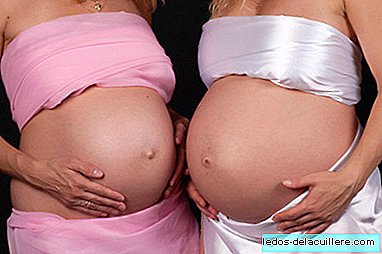
One sees these things and wonders, will the future be like that? In fact, it scares (a lot), and although a priori it seems crazy, it may not be so much considering that an artificial uterus has already been created with apparent success in sheep.
Product design students from the ARTEZ University of the Arts in the Netherlands have created Parturient, an art project that recreate an external uterus capable of gestating a baby in your living room. Its objective is to “open the debate between design, technology and ethics”. A fine line divides them and you want to draw attention to how far are we willing to go.
The dehumanization of pregnancy
Marta and George will soon be parents of a baby. They have chosen Parturient to get it, an artificial external uterus that for nine months nourishes and protects the baby in gestation. As you read it.
During this period, father and mother can continue with their life as they normally do, going to work and doing their daily lives, but they can also build the emotional bond with your baby through a communication device connected to the artificial uterus. In this way, the baby will get used to the voice of the parents. I am increasingly amazed!
Another portable device is also part of the Parturient ecosystem. Through it, parents can feel the movements and kicks of the baby as if it were inside the mother's womb. In turn, the mother can rock the device and caress it at a distance as if she had her baby in her arms.
To nurture it, the food that is introduced into the capsule is prepared as if an ink cartridge is plugged into a printer, and at night, all the information related to the growth of the baby is automatically sent to the hospital, from where the evolution is controlled.
One day, as if it were a Hatchimal that breaks its egg, you can uncover the capsule and receive the baby. Robin is born. You are already a happy family.
Will it be the future?

Ok, it's just an art project. No one has tried to create something like that, (at least as far as we know), but is it only a matter of time?
Nor is it so far away from the artificial uterus created by researchers at the Children's Hospital of Philadelphia and tested on lambs to know if it could be viable also for premature babies. The uterus consists of a plastic bag filled with amniotic-like fluid, connected by the umbilical cord to a machine designed to feed them. There they spent 28 days until it was time for them to be born.
In full debate on surrogacy and given the rise of in vitro fertilization, in a world in which technology advances by giant steps, Is it so crazy to think that it could be the future of pregnancy? The creators of the project invite us to think:
Imagine a future where the current limits of procreation no longer exist, where life can be created in a new way. A future where natural pregnancy is replaced by an artificial uterus.
Will conventional pregnancy be needed? And if not, what will be the consequences? Design, innovation, technology and ethics are part of this project that speculates on the feelings and future values that identify our humanity.












